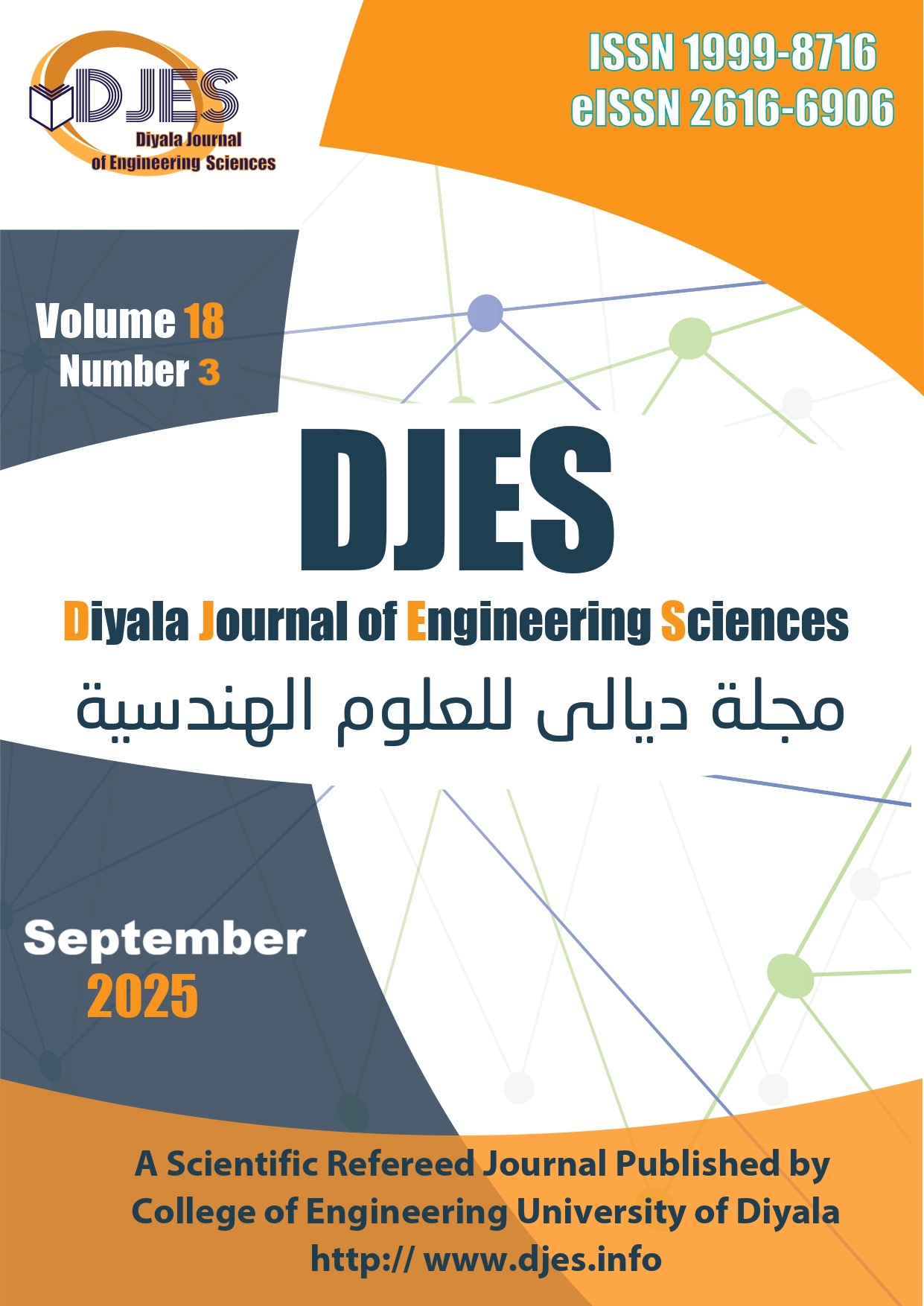Interpretable AI-Based Prediction of Elastic Modulus in Bamboo-Reinforced Polypropylene Using Mori–Tanaka and Neural Networks
DOI:
https://doi.org/10.24237/djes.2025.18307Keywords:
Elastic modulus, Artificial neural network, Polypropylene, Bamboo fiber, BiocompositesAbstract
This study presents a hybrid and interpretable modeling framework that integrates the Mori–Tanaka micromechanical model with artificial neural networks (ANNs) to predict the elastic modulus of bamboo-reinforced polypropylene composites. A synthetic dataset was created encompassing bamboo fiber volume fractions from 5% to 25%, enabling the ANN to generalize proficiently across diverse reinforcement setups. The ideal network architecture (2–15–1) attained superior predictive performance, with mean squared errors under 20 and regression coefficients surpassing 0.98, so validating the model's accuracy and robustness. To guarantee reliability, the model was evaluated on intermediate components not encountered during training, exhibiting consistent performance and resilience to overfitting. The interpretability of the black-box AI model was improved via sensitivity analysis and SHAP (Shapley Additive Explanations), which revealed that bamboo modulus was the primary factor affecting composite stiffness, contributing around 72% of predictive influence, whereas polypropylene accounted for 28%. These findings correspond with micromechanical theory and offer insights into material design methodologies. Combining physics-based modeling with artificial intelligence improves the accuracy of predictions and helps engineers make smart choices during the early stages of bio-composite development. This research enhances sustainable material innovation by offering a transparent, efficient, and scalable modeling tool suitable for comprehensive mechanical property forecasts and practical composite design.
Downloads
References
[1] M. Bahrami, J. Abenojar, and M. Á. Martínez, “Recent progress in hybrid biocomposites: Mechanical properties, water absorption, and flame retardancy,” 2020. doi: 10.3390/ma13225145.
[2] Khan, S. M. Rangappa, S. Siengchin, and A. M. Asiri, Biobased Composites: Processing, Characterization, Properties, and Applications. 2021. doi: 10.1002/9781119641803.
[3] M. Sasi Kumar et al., “Effect of Various Manufacturing Techniques on Mechanical Properties of Biofiber-Reinforced Composites,” in Sustainable Machining and Green Manufacturing, 2024. doi: 10.1002/9781394197866.ch3.
[4] K. M. F. Hasan, P. G. Horváth, M. Bak, and T. Alpár, “A state-of-the-art review on coir fiber-reinforced biocomposites,” 2021. doi: 10.1039/d1ra00231g.
[5] S. M. Rangappa, M. Puttegowda, J. Parameswaranpillai, S. Siengchin, and S. Gorbatyuk, Advances in Bio-Based Fiber: Moving Towards a Green Society. 2021. doi: 10.1016/B978-0-12-824543-9.00035-9.
[6] M. Zwawi, “A review on natural fiber bio-composites, surface modifications and applications,” 2021. doi: 10.3390/molecules26020404.
[7] C. Muthukumar, S. M. K. Thiagamani, S. Krishnasamy, J. Parameswaranpillai, and S. Siengchin, Biocomposites for Industrial Applications. Department of Mechanical Engineering, Kalasalingam Academy of Research and Education, Tamil Nadu, Krishnankoil, India: Elsevier, 2023. doi: 10.1016/C2021-0-00201-7.
[8] T. S. M. Kumar et al., “Mechanical, Thermal, Tribological, and Dielectric Properties of Biobased Composites,” in Biobased Composites: Processing, Characterization, Properties, and Applications, 2021. doi: 10.1002/9781119641803.ch5.
[9] S. V. Anulaya and B. Kandasubramanian, Advancements in Silk Bio-composites for Multifaceted Applications, vol. Part F3672. 2025. doi: 10.1007/978-981-97-7901-7_4.
[10] B. S. Dakshayini, K. B. Kancherla, B. Raju, and D. Roy Mahapatra, “Assessing the Structural Feasibility and Recyclability of Flax/PLA Bio-Composites for Enhanced Sustainability,” in SAE Technical Papers, 2024. doi: 10.4271/2024-26-0407.
[11] R. Reshmy et al., “Biodegradable polymer composites,” Post-Graduate and Research Department of Chemistry, Bishop Moore College, Mavelikara, India: Elsevier, 2021, pp. 393–412. doi: 10.1016/B978-0-12-821888-4.00003-4.
[12] D. K. Rajak, D. D. Pagar, and C. I. Pruncu, “Failure Mechanisms of Biobased Composites,” Department of Mechanical Engineering, Sandip Institute of Technology and Research Centre, Maharashtra, Nashik, India: wiley, 2021, pp. 87–106. doi: 10.1002/9781119641803.ch7.
[13] A. V Kiruthika, “Physico-Mechanical Properties of Biobased Composites,” Seethalakshmi Achi College for Women, Tamil Nadu, Pallathur, India: wiley, 2021, pp. 153–166. doi: 10.1002/9781119641803.ch11.
[14] A. Ari, M. Karahan, H. A. M. Ahmed, O. Babiker, and R. M. A. Dehşet, “A Review of Cellulosic Natural Fibers’ Properties and Their Suitability as Reinforcing Materials for Composite Panels and Applications,” 2023. doi: 10.1177/24723444221147365.
[15] M. M. Azad, M. Ejaz, A. U. R. Shah, S. Kamran Afaq, and J. Il Song, “Static mechanical properties of bio-fiber-based polymer composites,” in Advances in Bio-Based Fiber: Moving Towards a Green Society, 2021. doi: 10.1016/B978-0-12-824543-9.00034-7.
[16] M. Puttegowda, “Eco-friendly composites: exploring the potential of natural fiber reinforcement,” vol. 7, no. 5, 2025, doi: 10.1007/s42452-025-06981-8.
[17] S. Palanisamy, K. Vijayananth, T. M. Murugesan, M. Palaniappan, and C. Santulli, “The prospects of natural fiber composites: A brief review,” 2024. doi: 10.1016/j.ijlmm.2024.01.003.
[18] S. N. Surip, S. N. R. Muhammad, M. N. Zakaria, E. S. Ali, and J. Gisip, “Preparation methods of biofiber-based polymer composites,” in Advances in Bio-Based Fiber: Moving Towards a Green Society, 2021. doi: 10.1016/B978-0-12-824543-9.00016-5.
[19] S. Barbhuiya, B. B. Das, K. Kapoor, A. Das, and V. Katare, “Mechanical performance of bio-based materials in structural applications: A comprehensive review,” vol. 75, 2025, doi: 10.1016/j.istruc.2025.108726.
[20] H. Abdollahiparsa, A. Shahmirzaloo, P. Teuffel, and R. Blok, “A review of recent developments in structural applications of natural fiber-Reinforced composites (NFRCs),” Composites and Advanced Materials, vol. 32, 2023, doi: 10.1177/26349833221147540.
[21] N. S. Yatigala, D. S. Bajwa, and S. G. Bajwa, “Compatibilization improves physico-mechanical properties of biodegradable biobased polymer composites,” Compos Part A Appl Sci Manuf, vol. 107, 2018, doi: 10.1016/j.compositesa.2018.01.011.
[22] R. Kumar, C. Bhargav, and S. Bhowmik, “Bamboo fibre reinforced thermoset and thermoplastic polymer composites: A short review,” in AIP Conference Proceedings, 2018. doi: 10.1063/1.5049114.
[23] N. M. Nurazzi et al., “Mechanical performance evaluation of bamboo fibre reinforced polymer composites and its applications: A review,” Functional Composites and Structures, vol. 4, no. 1, 2022, doi: 10.1088/2631-6331/ac5b1a.
[24] L. Altay, M. Sarikanat, M. Salam, T. Uysalman, and Y. Seki, “The effect of various mineral fillers on thermal, mechanical, and rheological properties of polypropylene,” Research on Engineering Structures and Materials, vol. 7, no. 3, pp. 361–373, 2021, doi: 10.17515/resm2021.258ma0213.
[25] H. Zhao, Q. Miao, L. Huang, X. Zhou, and L. Chen, “Preparation of long bamboo fiber and its reinforced polypropylene membrane composites,” Journal of Forestry Engineering, vol. 6, no. 5, 2021, doi: 10.13360/j.issn.2096-1359.202101020.
[26] S. Zhang, W. Yao, H. Zhang, and K. Sheng, “Polypropylene biocomposites reinforced with bamboo particles and ultrafine bamboo-char: The effect of blending ratio,” Polym Compos, vol. 39, 2018, doi: 10.1002/pc.24805.
[27] M. L. Sánchez, W. Patiño, and J. Cárdenas, “Physical-mechanical properties of bamboo fibers-reinforced biocomposites: Influence of surface treatment of fibers,” Journal of Building Engineering, vol. 28, 2020, doi: 10.1016/j.jobe.2019.101058.
[28] M. Lakhera, R. Agrawal, D. Dhar, and A. Jain, “On the Application of the Mean-Field Homogenization for Non-isotropic Matrix,” Journal of The Institution of Engineers (India): Series C, vol. 105, no. 3, pp. 683–692, 2024, doi: 10.1007/s40032-024-01062-y.
[29] F. Díaz-Gómez, J. León-Becerra, and C. Tavera-Ruiz, “Mori-Tanaka homogenization for biocomposites: recycled PET and agroindustrial biomass integration,” Multidiscipline Modeling in Materials and Structures, 2025, doi: 10.1108/MMMS-10-2024-0302.
[30] M. Chandrasekar, P. S. Venkatanarayanan, K. Senthilkumar, T. S. M. Kumar, S. Siengchin, and J. J. Britto, “Computational modeling of biocomposites,” in Green Biocomposites for Biomedical Engineering: Design, Properties, and Applications, 2021. doi: 10.1016/B978-0-12-821553-1.00012-0.
[31] E. Chávez-Angel et al., “Applied Artificial Intelligence in Materials Science and Material Design,” Advanced Intelligent Systems, 2025, doi: 10.1002/aisy.202400986.
[32] R. Ramful and M. S. Casseem, “Prediction of the Mechanical Characteristic of Bamboo Using Deep Neural Network,” in International Conference on Electrical, Computer, Communications and Mechatronics Engineering, ICECCME 2023, 2023. doi: 10.1109/ICECCME57830.2023.10253219.
[33] K. Nasri and L. Toubal, “Artificial Neural Network Approach for Assessing Mechanical Properties and Impact Performance of Natural-Fiber Composites Exposed to UV Radiation,” Polymers (Basel), vol. 16, no. 4, 2024, doi: 10.3390/polym16040538.
[34] K. Saada et al., “Exploring tensile properties of bio composites reinforced date palm fibers using experimental and Modelling Approaches,” Mater Chem Phys, vol. 314, 2024, doi: 10.1016/j.matchemphys.2023.128810.
[35] R. Al-Jarrah and F. M. AL-Oqla, “A novel integrated BPNN/SNN artificial neural network for predicting the mechanical performance of green fibers for better composite manufacturing,” Compos Struct, vol. 289, 2022, doi: 10.1016/j.compstruct.2022.115475.
[36] R. Kumar, P. Srivastava, A. P. Agrawal, S. Kumar, and V. Kumar, “Development and Characterization of Polypropylene-Carbon Nanotubes (PP-CNT) Composites: An Overview Toward Hurdles and Achievements,” Macromol Symp, vol. 414, no. 1, 2025, doi: 10.1002/masy.202400058.
[37] T. Nakaoki and Y. Inaji, “Molecular structure of isotactic polypropylene formed from homogeneous solution. Gelation and crystallization,” Polym J, vol. 34, no. 7, 2002, doi: 10.1295/polymj.34.539.
[38] Y. Xu, M. Wong, J. Yang, Z. Ye, P. Jiang, and S. Zheng, “Dynamics of Carbon Accumulation During the Fast Growth Period of Bamboo Plant,” Botanical Review, vol. 77, no. 3, pp. 287–295, 2011, doi: 10.1007/s12229-011-9070-3.
[39] L. C. Dlamini, S. Fakudze, G. G. Makombe, S. Muse, and J. Zhu, “Bamboo as a Valuable Resource and its Utilization in Historical and Modern-day China,” Bioresources, vol. 17, no. 1, pp. 1926–1938, 2022, doi: 10.15376/biores.17.2.Dlamini.
[40] D. Malkowska, J. Norman, and D. Trujillo, “Design of a connection with metal plates and screws in natural bamboo – worked example,” Structural Engineer, vol. 103, no. 1, pp. 30–35, 2025. doi: 10.56330/BUEC7043.
[41] M. Haggui, Z. Jendli, A. El Mahi, A. Akrout, and M. Haddar, “Multi-scale analysis of the mechanical behaviour of a flax fibre reinforced composite under low-velocity impact,” J Compos Mater, vol. 58, no. 2, pp. 217–234, 2024, doi: 10.1177/00219983231221056.
[42] Y. Zuo, W. Li, P. Li, W. Liu, X. Li, and Y. Wu, “Preparation and characterization of polylactic acid-g-bamboo fiber based on in-situ solid phase polymerization,” Ind Crops Prod, vol. 123, 2018, doi: 10.1016/j.indcrop.2018.07.024.
[43] D.-W. Kim, S.-M. Park, and J. H. Lim, “Prediction of the transverse elastic modulus of the unidirectional composites by an artificial neural network with fiber positions and volume fraction,” Functional Composites and Structures, vol. 3, no. 2, 2021, doi: 10.1088/2631-6331/abf8f8.
[44] Miaoli, W. Xiaolong, and H. Honggui, “Accelerated Levenberg-Marquardt Algorithm for Radial Basis Function Neural Network,” in Proceedings - 2020 Chinese Automation Congress, CAC 2020, 2020. doi: 10.1109/CAC51589.2020.9327740.
[45] D. Chicco, M. J. Warrens, and G. Jurman, “The coefficient of determination R-squared is more informative than SMAPE, MAE, MAPE, MSE and RMSE in regression analysis evaluation,” PeerJ Comput Sci, vol. 7, 2021, doi: 10.7717/PEERJ-CS.623.
[46] Z. Laabid, A. Lakhdar, K. Mansouri, and A. Siadat, “Implementation of artificial intelligence in the prediction of the elastic characteristics of bio-loaded polypropylene with bamboo fibers,” International Journal of Electrical and Computer Engineering, vol. 14, no. 6, pp. 6904–6912, 2024, doi: 10.11591/ijece.v14i6.pp6904-6912.
Downloads
Published
Issue
Section
License
Copyright (c) 2025 SAMEH FUQAHA, guntur nugroho, Ahmad Zaki

This work is licensed under a Creative Commons Attribution 4.0 International License.












